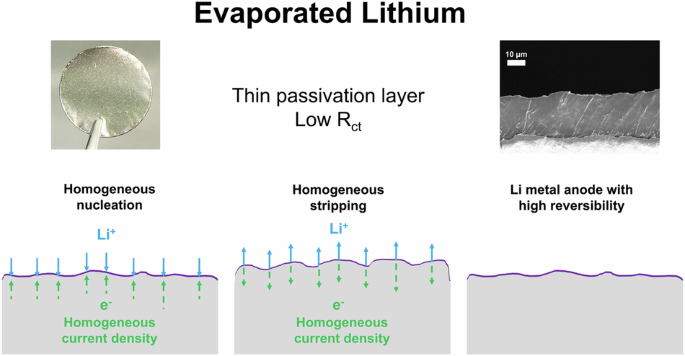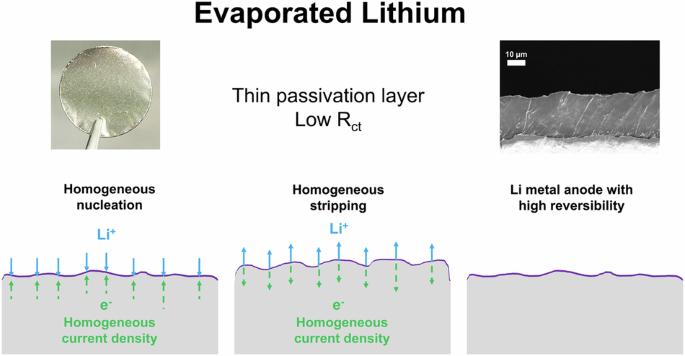High performance ultra-thin lithium metal anode enabled by vacuum thermal evaporation
IF 9.6
Q1 MATERIALS SCIENCE, MULTIDISCIPLINARY
引用次数: 0
Abstract
The passivation layer that naturally forms on the lithium metal surface contributes to dendrite formation in lithium metal batteries by affecting lithium nucleation uniformity during charging. Herein, we propose using vacuum thermal evaporation to produce a high-performance ultra-thin lithium metal anode (≤25 µm) with a native layer much thinner than that of extruded lithium. The evaporated lithium metal shows significantly reduced charge-transfer resistance, resulting in uniform and dense lithium plating in both carbonate and ether electrolytes. This study reveals that the evaporated lithium metal outperforms the extruded version in ether electrolyte and with LiFePO4 cathodes, showing a 30% increase in cycle life. Additionally, when paired with LiNi0.6Mn0.2Co0.2O2 cathodes in carbonate electrolyte, the evaporated anode’s cycle life is tripled compared to the extruded lithium metal. This demonstrates that vacuum thermal evaporation is a viable method for producing ultra-thin lithium metal anodes that prevent dendrite growth due to their excellent surface condition. The passivation layer that forms on the surface of lithium metal contributes to lithium nucleation uniformity during battery charging. Here, vacuum thermal evaporation produces an ultra-thin lithium metal anode with reduced charge-transfer resistance that results in a more homogeneous and denser lithium plating.


通过真空热蒸发实现高性能超薄锂金属负极
锂金属表面自然形成的钝化层会影响充电过程中锂成核的均匀性,从而导致锂金属电池中枝晶的形成。在此,我们提出利用真空热蒸发来生产高性能超薄锂金属负极(≤25 µm),其原生层比挤压锂的原生层薄得多。蒸发锂金属大大降低了电荷转移电阻,在碳酸盐和乙醚电解质中都能形成均匀致密的锂镀层。这项研究表明,蒸发锂金属在乙醚电解质和磷酸铁锂正极中的性能优于挤压锂金属,循环寿命延长了 30%。此外,在碳酸盐电解液中与 LiNi0.6Mn0.2Co0.2O2 正极搭配时,蒸发阳极的循环寿命是挤压金属锂的三倍。这表明真空热蒸发是生产超薄锂金属阳极的一种可行方法,由于其良好的表面状态,可以防止枝晶的生长。锂金属表面形成的钝化层有助于电池充电过程中锂成核的均匀性。在这里,真空热蒸发法生产出的超薄锂金属阳极可降低电荷转移电阻,从而获得更均匀、更致密的锂镀层。
本文章由计算机程序翻译,如有差异,请以英文原文为准。
求助全文
约1分钟内获得全文
求助全文
来源期刊

Communications Materials
MATERIALS SCIENCE, MULTIDISCIPLINARY-
CiteScore
12.10
自引率
1.30%
发文量
85
审稿时长
17 weeks
期刊介绍:
Communications Materials, a selective open access journal within Nature Portfolio, is dedicated to publishing top-tier research, reviews, and commentary across all facets of materials science. The journal showcases significant advancements in specialized research areas, encompassing both fundamental and applied studies. Serving as an open access option for materials sciences, Communications Materials applies less stringent criteria for impact and significance compared to Nature-branded journals, including Nature Communications.
 求助内容:
求助内容: 应助结果提醒方式:
应助结果提醒方式:


